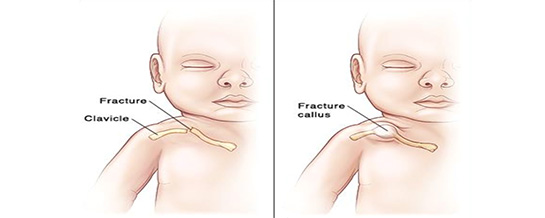How to Care for Your Child with Clavicle Fracture
This leaflet will provide you with information about clavicle fracture, symptoms, diagnosis, treatment and home care advice.

What is Clavicle Fracture?
The clavicle sometimes called the "collarbone," connects the breastbone to the shoulder blade. A clavicle fracture is when a child breaks his or her clavicle (collarbone)
What are the symptoms of Clavicle Fracture?
Symptoms of a clavicle fracture may include:
- Pain in the area of the clavicle when moving the arm
- Swelling and bruises over the injured area
- Feeling the bone snap or crack (when the fracture happens)
A clavicle fracture can also make the clavicle look like it's out of position.
How is Clavicle Fracture diagnosed?
The doctor will ask you few questions about your child's health and examine your child. Your doctor will request an x-ray for your child's injured clavicle.
How is Clavicle Fracture treated?
Most broken Clavicle (collarbones) heal well with supportive management at home, and this includes:
- Ice to help with pain and swelling. Put an icepack, cold gel pack, or bag of frozen vegetables over the collarbone for 20-30 minutes every 2-3 hours. Be sure to put a towel between the ice/cold pack and your child's skin.
- Arm support, such as a sling or shoulder immobilizer. Your child should wear the sling or immobilizer for about three weeks
- Pain medicine. If your doctor advises giving medication for pain, you can give:
- Paracetamol (any brand) Or, Ibuprofen (any brand)
- Follow the instruction on the medicine package for the correct dose for your child
- Do not give your child Aspirin to as this can cause a serious complication
- As the fracture heals, it often develops a bony bump, which you can see and feel. This is called a "callus" and is a normal part of healing. In children, the callus usually disappears.
- A follow up is not needed unless your child is still in pain and not moving the shoulder three weeks after the injury
Home care advice
- Ensure your child takes appropriate rest at home
- Give pain medicine as directed by your doctor
- For the first three weeks, your child should:
- Avoid raising the arms above the shoulder.
- Avoid lifting anything that weighs more than 5 pounds (2.3 kg).
- Stay out of all sports and physical education.
- Help your child do all gentle exercises of his arm to prevent elbow and shoulder stiffness and help with muscle strength.
When can my child go back to playing sports?
Your doctor will let you know when your child can go back to sports. This is usually when:
- There is no pain when you press on the collarbone.
- The shoulder strength is normal.
- Your child can move and use the arm without pain.
In general, children can go back to non-contact sports (such as running or swimming) in about three weeks. Children can go back to contact sports (such as football or hockey) in 6-8 weeks.
When should I seek medical advice?
Seek medical care if your child:
- Has pain or swelling that gets worse.
- The arm is cold, pale, or numb.

